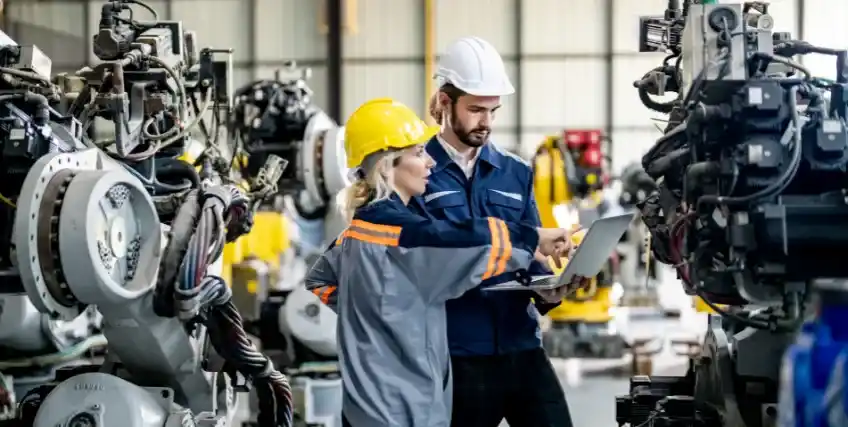Can’t Afford New Gear? Business Equipment Financing Could Save Your Quarter
June 30, 2025 | Last Updated on: June 30, 2025

Tools and machines are the heart of your business, whether it’s a commercial-grade espresso machine, hydraulic lift, dental X-ray unit, or POS system. However, replacing outdated gear can feel impossible when cash flow is tight. The good news? There’s a solution that doesn’t involve draining your savings: Business equipment financing.
Equipment financing loans are a smart way to get the necessary tools you need, right when you actually need them. From refrigerators to excavators, the right equipment can keep your operations stable.
So, let’s dive into this guide, where we’ll see how business equipment financing works, what are the advantages and disadvantages of using it, and how small business owners can qualify for it. We will also list the top industries that can benefit from business equipment financing.
What is Business Equipment Financing
Business equipment financing is a funding solution that allows you to get essential tools for your business. You can get necessary equipment such as bakery ovens, welding machines, or commercial dishwashers without paying a hefty amount upfront. Here the lender pays for the gear, and you pay them back through monthly payments.
This business financing solution gives you flexibility and speed. You don’t need to delay operations or empty your emergency fund. Instead, you get instant access to what you need and repay in predictable chunks.
Thousands of small businesses rely on equipment financing to stay sharp in the competitive market. Whether you own a cafe, restaurant, retail shop, or construction business, this financing option can keep your business on track.
Additionally, business equipment financing covers a wide range of equipment purchases such as used equipment, heavy equipment, office furniture, medical equipment, and more. The equipment here itself serves as collateral, and most equipment loans are structured with fixed monthly payments and loan terms suited to your business needs.
How Does Business Equipment Financing Work for Small Business Owners
Small business owners often find themselves in a race against time when their equipment breaks down or they can’t keep up. Imagine running a coffee shop with a broken espresso machine. This means that if you’re delaying repairs or upgrades, you are turning away from customers or losing efficiency fast.
This is where business equipment financing can make a huge difference. It offers a way to quickly access essential tools without paying large upfront costs. This helps small businesses move forward without financial strain.
Here’s how the application process for business equipment looks like:
- Submit your business equipment or heavy equipment loan application to a lender.
- Get credit approval based on your financials and personal credit.
- The lender pays the vendor or reimburses you for the equipment cost.
- Repayment terms are set, often at a fixed rate, with monthly loan payments.
Moreover, the lender may require a down payment, especially for new equipment or construction equipment. Also, some of the best equipment financing companies allow you to finance nearly any type of equipment essential to your business operations.
Understanding Equipment Leasing
Equipment leasing is a rental agreement. Here you pay to use the piece of equipment for a set lease term without taking full ownership.
This business financing option works well when equipment is likely to become outdated or when businesses are scaling fast. At the end of the lease, you may return the equipment, or purchase it at a reduced cost.
Key Differences:
- Equipment Financing: You have full ownership of equipment after final payment.
- Equipment Leasing: You have flexibility with lower monthly costs, but no ownership unless bought at the end of the lease agreement.
Therefore, various lenders and providers offer both options, giving you flexibility based on your business needs, cash flow, and your preferred payment options.
Benefits of Business Equipment Financing
When the fryer in your kitchen goes cold or your X-rat machine breaks mid-week downtime isn’t just inconvenient, it’s expensive. Small businesses typically run on speed and reliability, and outdated or faulty equipment can mean lost revenue and unhappy customers.
Hence, business owners can choose business equipment financing solutions instead of waiting to afford it outright. This funding solution helps act fast, stay operational, and invest in growth, without draining the working capital.
Here are some of the benefits of equipment loans for new businesses and existing ones.
Preserves Cashflow
Business equipment financing helps avoid large one-time payments. This helps small business owners to keep funds available for payroll, marketing, and scaling. As a result, it maintains a healthy balance while still meeting your financing needs.
Quick Credit Approval
Many lenders offer same-week decisions. You won’t have to wait for months to access the necessary tools. Therefore, equipment financing can be a savior for startups needing immediate business equipment.
Builds Credit
On-time loan payments often help in improving your credit score if the lender reports to credit bureaus. As a result, a strong credit score can assist with future loans, including SBA (Small Business Administration) loan programs and other small business loans from traditional banks.
Tax Savings
With equipment financing, you may be able to qualify for Section 179 or depreciation deductions. This means you can save money annually while using high-performance tools for your business. Hence, this is a smart way to handle equipment costs and boost your annual revenue. However, it is best to consult a tax professional.
Predictable Payments
Small business owners can plan their budget as business equipment financing offers fixed-rate monthly payments. With this, you know what to expect, which reduces stress and supports long-term planning.
Pros and Cons of Business Equipment Financing
Every financing solution comes with its own set of trade-offs, and equipment financing is no different. This surely gives small businesses a powerful way to grow, but it also comes with a few considerations.
Here are the advantages and disadvantages of using equipment financing.
| Pros | Cons |
|---|---|
| You own the equipment after repayment | You’ll pay more over time due to interest |
| Keeps working capital available | May require a down payment |
| May help build credit over time | Some lenders charge origination or early payment fees |
| Often faster than traditional banks | Equipment may depreciate in value |
| Possible tax write-offs | Missed payments affect credit score |
How to Qualify for Business Equipment Financing
Picture this: You’ve finally landed a major project, but your machinery is on its last leg. Or maybe your client base is growing, but you still rely on outdated systems that can’t keep up. This is your sign to scale or replace your outdated gear with a new one. However, you are required to keep your financial house in order to secure the necessary funds.
This is where preparation becomes the most important step in business financing. Lenders want to reduce risk, so presenting yourself as a reliable borrower boosts your chances of approval.
Here’s how to improve approval odds.
- Know Your Credit Score: Make sure you have a FICO score of 670 or above. However, some lenders do accept lower scores, but terms may vary. A stronger credit score may also unlock lower interest rates.
- Organize Your Financial Documents: Gather all the necessary documents such as tax returns, bank account statements, profit/loss statements, and cash flow reports. These help prove your business is stable and creditworthy.
- Have a Clear Business Plan: Always draft a clear business plan explaining how the equipment supports your operations or increases revenue. Lenders like to see how the investment will impact your business positively.
- Identify What You Need: Always be specific and list the equipment model, price, and vendor details. Providing clarity speeds up the loan approval process and builds lender confidence.
- Compare Lenders and Providers: Before considering business equipment financing, review interest rates, loan amount limits, and repayment terms. Also, evaluate customer service, flexibility, reputation of each provider, and ensure they’re part of member
Quick Advice: Always compare business equipment financing options from multiple lenders. You can also consult an expert for your business banking or loan payments strategy. Also, remember, that lenders should be FDIC insured.
The Bottom Line
To sum this up, understand that every lost day in your business costs you revenue. Your old equipment can delay projects, frustrate staff, and reduce customer satisfaction.
Business equipment financing offers a strategic way to stay operational, competitive, and ready for growth. It ensures that you aren’t sidelined by outdated tools or missed opportunities. From securing new machinery to updating worn-out systems, this financing path keeps your business future-ready.
Need the tools to finish the job? Don’t wait for the capital to catch up. Apply for business equipment financing today and get back to doing what you do best.
FAQs About Business Equipment Financing
What is the difference between equipment financing and leasing?
Business equipment financing usually leads to ownership, while equipment leasing gives temporary access with lower upfront costs. Many business owners explore both options, depending on their cash flow and how long they plan to use the equipment. Therefore, it comes down to what is more flexible for your business operations.
Can a startup apply for business equipment financing?
Startups can sometimes qualify, especially if they show solid financial planning and a strong business model. However, lenders may still ask for a higher down payment or additional paperwork. Hence, the terms might vary depending on the lender’s risk assessment.
What types of equipment can be financed?
Most lenders cover a wide range of equipment, from medical devices to trucks and even office furniture. What you can finance often depends on your provider and how essential the equipment is to your business. Additionally, used equipment might also qualify under certain conditions.
How does my credit score impact equipment loan approval?
A stronger credit score often leads to better interest rates and loan terms. However, it's not the only factor. Lenders might also look at cash flow, annual revenue, and collateral. Therefore, every loan application tends to be weighed a bit differently.
Can I get financing for used equipment?
Many lenders do offer financing for used tools and machinery, though the terms might differ slightly. The equipment’s age, condition, and value usually play an important role. Hence, it's worth checking with a few providers to compare your options.
Frequent searches leading to this page
Term Loans are made by Itria Ventures LLC or Cross River Bank, Member FDIC. This is not a deposit product. California residents: Itria Ventures LLC is licensed by the Department of Financial Protection and Innovation. Loans are made or arranged pursuant to California Financing Law License # 60DBO-35839




